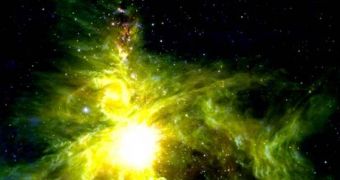The Orion Nebula is, perhaps, one of the most scrutinized objects in the sky, mainly because it can be seen with the naked eye during bright nights. Located in the Orion Constellation, some 1,270 light-years away from Earth, the giant formation has been recently proven to be the stage for the formation of countless new stars, in a process that is extremely chaotic and erratic. Also, astronomers say that the amount of bodies being generated classify the Orion Nebula as one of the most prolific in the known Universe.
“With such a large number of young stars, we can study the 'demographics' of star birth. This study will give us an idea of how long it takes baby stars to bulk up by pulling in gas from the surrounding cloud, what ultimately stops a star from growing bigger, and how a star's birth is influenced by other stars in the stellar nursery,” Astronomer Tom Megeath, from the University of Toledo, in Ohio, US, explained.
The recent survey is the most complete one of the region, cataloging a very large number of stars, as well as the processes and influences that occur between them. The gaseous hydrogen “bullets” that have come out at supersonic speeds from the poles of forming celestial bodies have also been observed, and their influence on the gas and dust cloud that make up the nebula assessed.
This type of jets normally occurs only when the star is in its forming process. At the beginning, it starts spinning some gas and dust, and then slowly takes on mass through accretion. While it does this, the chance of emitting hydrogen jets is very significant. However, once the new star ignites and stops consuming matter around it, it seldom emits this type of jets again. Still, after the young celestial body is complete, the jets become a sort of radio signal for astronomers, who can thus pinpoint the exact position of the new baby star.
“Each jet is traveling at tens or even hundreds of miles per second; the jets extend across many trillions of miles of interstellar space,” UKIRT Astronomer Chris Davis stated, as quoted by Space. The United Kingdom Infra-Red Telescope (UKIRT) and the Spitzer Space Telescope have been the two observatories used for these observations, as only infrared telescopes are able to penetrate the highly dense clouds of gas and dust that protect stellar nurseries across the Universe.

 14 DAY TRIAL //
14 DAY TRIAL //